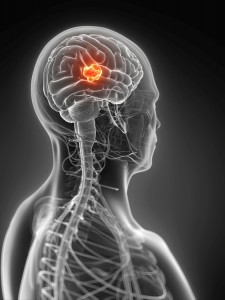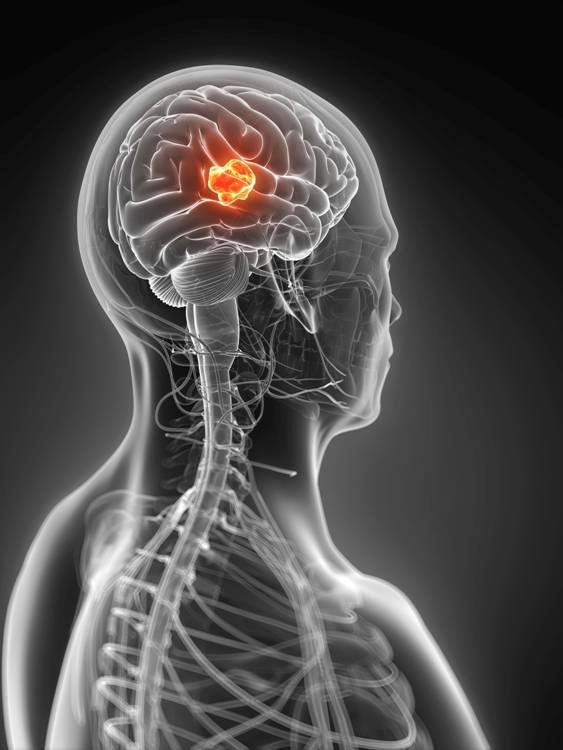Lighting Up Brain Tumors the Photodynamic Way
Most brain tumors are classified as gliomas, tumors that arise from the glial cells within the brain or spine. Gliomas can be a particularly lethal form of cancer because they infiltrate the normal brain tissues and thus pose a huge challenge to neurosurgeons, and being able to effectively image the glioma cells could pave a way for being able to surgically remove the brain tumor without damaging the brain itself.
Much research suggests that a precise analysis of the brain tumor tissue is essential for carrying out proper treatment. Furthermore, complete surgical removal of the tumor is linked with better survival. Nevertheless, inadequate tumor analysis and incomplete removal of the tumor are not uncommon, and both problems may be linked with an insufficient ability to visualize the brain tumor tissue during surgery.
The dye known as 5-aminolevulinic acid (5-ALA) is currently used for fluorescence-guided surgery of high-grade gliomas. When 5-ALA is administered, it leads to the increased production of a substance known as protoporphyrin or PpIX in tumors. Upon exposure to light, PpIX causes the tumor to “glow” or fluoresce during the operation, thus enabling the surgeon to clearly see where the tumor tissue is.
Exploiting this principle of 5-ALA fluorescence during surgery, researchers from the Institute of Neurology and the Comprehensive Cancer Center, based at the Medical University of Vienna (Austria), recently reviewed the evidence for using PDT in the treatment of gliomas. In a controlled study, they found a significantly higher rate of complete resections of high-grade gliomas (the most aggressive brain tumors) using a new 5-ALA fluorescence–guided surgical approach.
Overall, their study demonstrated that 5-ALA is not only of major importance for surgically removing high-grade gliomas, but also for intra-operative visualization of abnormal cells that could indicate the presence of low-grade gliomas. They predict that the new technique may become “a novel standard in brain tumor surgery that optimizes the patient management and improves the patient prognosis by maximizing the extent of tumor resection and enabling a precise histopathological tumor diagnosis,” as reported in ,” as reported in the July-August 2014 issue of Clinical Neuropathology.
Photodynamic Insights into Better Treatment
Photodynamic therapy (PDT) for cancer involves the use of a light-sensitizng agent that concentrates in tumors and results in their destruction upon exposure to visible light. These days, PDT is a clinically established modality for treatment of many cancers.
As mentioned above, the use of 5-ALA is an example of a light-sensitizing agent or photosensitizer. 5-ALA has proven its rationale in fluorescence-guided surgery of malignant brain tumors due to a selective tumor uptake. Researchers at University Hospital of Lille (France), experimental and clinical studies have established ALA-PDT as a valuable adjuvant therapy in the management of malignant brain tumors, as reported in the September 2014 issue of Photodiagnosis and Photodynamic Therapy.
A more skeptical view is offered by the neurosurgeons at the Walton Centre for Neurology and Neurosurgery in Liverpool (UK). Their review concluded that the evidence for 5-ALA fluorescence-guided surgery is of low quality. Until better-quality clinical studies are conducted, these researchers contend that the jury is still out on the efficacy of this photodynamic approach, as reported in the January 2014 issue of Cochrane Database Systematic Reviews.
Support us by buying our book, The Medicine of Light, and ebooks from our Photoimmune Discoveries eBook Series.
Sources
Widhalm G. Intra-operative visualization of brain tumors with 5-aminolevulinic acid-induced fluorescence. Clin Neuropathol. 2014 Jul-Aug;33(4):260-78.
Ma H, Gao Z, Yu P, Shen S, Liu Y, Xu B. A dual functional fluorescent probe for glioma imaging mediated by blood-brain barrier penetration and glioma cell targeting. Biochem Biophys Res Commun. 2014 Jun 20;449(1):44-8.
Tetard MC, Vermandel M, Mordon S, Lejeune JP, Reyns N. Experimental use of Photodynamic Therapy in high grade gliomas: a review focused on 5-aminolevulinic acid. Photodiagnosis Photodyn Ther. 2014 Sep;11(3):319-330.
Barone DG, Lawrie TA, Hart MG. Image guided surgery for the resection of brain tumours. Cochrane Database Syst Rev. 2014 Jan 28;1:CD009685. doi: 10.1002/14651858.CD009685.pub2.
© Copyright 2014, Photoimmune Discoveries, BV




 English
English Français
Français Deutsch
Deutsch Nederlands
Nederlands